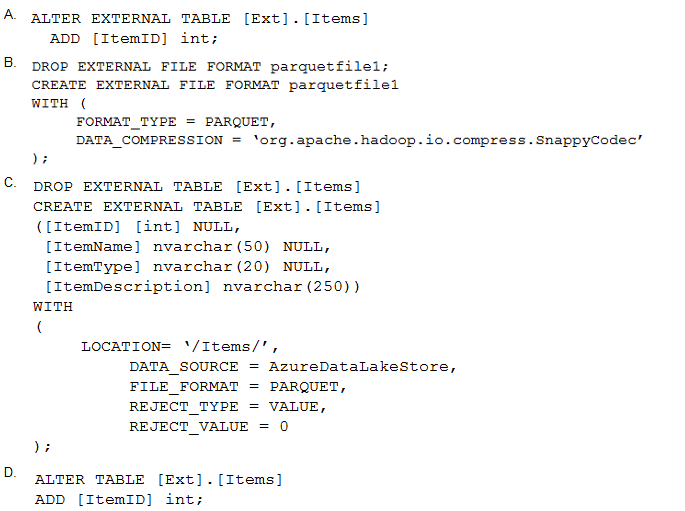Microsoft Data Engineering on Microsoft Azure DP-203 Exam Practice Test
You have an enterprise data warehouse in Azure Synapse Analytics named DW1 on a server named Server1.
You need to determine the size of the transaction log file for each distribution of DW1.
What should you do?
Answer : A
For information about the current log file size, its maximum size, and the autogrow option for the file, you can also use the size, max_size, and growth columns for that log file in sys.database_files.
Note: This question is part of a series of questions that present the same scenario. Each question in the series contains a unique solution that might meet the stated goals. Some question sets might have more than one correct solution, while others might not have a correct solution.
After you answer a question in this scenario, you will NOT be able to return to it. As a result, these questions will not appear in the review screen.
You have an Azure Storage account that contains 100 GB of files. The files contain text and numerical values. 75% of the rows contain description data that has an average length of 1.1 MB.
You plan to copy the data from the storage account to an Azure SQL data warehouse.
You need to prepare the files to ensure that the data copies quickly.
Solution: You modify the files to ensure that each row is less than 1 MB.
Does this meet the goal?
Answer : A
When exporting data into an ORC File Format, you might get Java out-of-memory errors when there are large text columns. To work around this limitation, export only a subset of the columns.
https://docs.microsoft.com/en-us/azure/sql-data-warehouse/guidance-for-loading-data
You have an enterprise data warehouse in Azure Synapse Analytics.
Using PolyBase, you create an external table named [Ext].[Items] to query Parquet files stored in Azure Data Lake Storage Gen2 without importing the data to the data warehouse.
The external table has three columns.
You discover that the Parquet files have a fourth column named ItemID.
Which command should you run to add the ItemID column to the external table?

You have an Azure Synapse Analytics dedicated SQL Pool1. Pool1 contains a partitioned fact table named dbo.Sales and a staging table named stg.Sales that has the matching table and partition definitions.
You need to overwrite the content of the first partition in dbo.Sales with the content of the same partition in stg.Sales. The solution must minimize load times.
What should you do?
Answer : A
You are implementing a batch dataset in the Parquet format.
Data tiles will be produced by using Azure Data Factory and stored in Azure Data Lake Storage Gen2. The files will be consumed by an Azure Synapse Analytics serverless SQL pool.
You need to minimize storage costs for the solution.
What should you do?
Answer : C
An external table points to data located in Hadoop, Azure Storage blob, or Azure Data Lake Storage. External tables are used to read data from files or write data to files in Azure Storage. With Synapse SQL, you can use external tables to read external data using dedicated SQL pool or serverless SQL pool.
https://docs.microsoft.com/en-us/azure/synapse-analytics/sql/develop-tables-external-tables
Note: This question is part of a series of questions that present the same scenario. Each question in the series contains a unique solution that might meet the stated goals. Some question sets might have more than one correct solution, while others might not have a correct solution.
After you answer a question in this section, you will NOT be able to return to it. As a result, these questions will not appear in the review screen.
You have an Azure Synapse Analytics dedicated SQL pool that contains a table named Table1.
You have files that are ingested and loaded into an Azure Data Lake Storage Gen2 container named container1.
You plan to insert data from the files in container1 into Table1 and transform the dat
a. Each row of data in the files will produce one row in the serving layer of Table1.
You need to ensure that when the source data files are loaded to container1, the DateTime is stored as an additional column in Table1.
Solution: You use a dedicated SQL pool to create an external table that has an additional DateTime column.
Does this meet the goal?
Answer : B
Instead use the derived column transformation to generate new columns in your data flow or to modify existing fields.
https://docs.microsoft.com/en-us/azure/data-factory/data-flow-derived-column
You have an Azure Synapse Analytics workspace named WS1 that contains an Apache Spark pool named Pool1.
You plan to create a database named D61 in Pool1.
You need to ensure that when tables are created in DB1, the tables are available automatically as external tables to the built-in serverless SQL pod.
Which format should you use for the tables in DB1?
Answer : A
Serverless SQL pool can automatically synchronize metadata from Apache Spark. A serverless SQL pool database will be created for each database existing in serverless Apache Spark pools.
For each Spark external table based on Parquet or CSV and located in Azure Storage, an external table is created in a serverless SQL pool database.
https://docs.microsoft.com/en-us/azure/synapse-analytics/sql/develop-storage-files-spark-tables